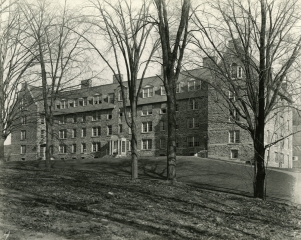would no longer be accommodated at the fraternity houses. George Cobb again headed the appeal for funds which alumni and friends gave as an affectionate tribute to Mr. Colgate. Norman F. S. Russell,’01, the capable and devoted Chairman of the Trustee Committee on Buildings and Grounds, was especially active in working with Mr. Chambers in designing the building and overseeing construction.
Though not a University property, Colgate Inn was an important center for many University activities. Built in 1925 by a corporation of alumni and local residents, it replaced the old Park House which had stood on the same site for over a century.
The faculty in 1922 numbered 54 of whom 6 were in the Seminary and 48 in the College. By 1942 the latter group reached 90. The ratio of teachers to students dropped from approximately 1 to 18 to 1 to 11. Often deceased or retiring professors were replaced by men in the instructors rank, a practice which lowered the average age and average salary. The salary scale, which in 1923, was very modest in






